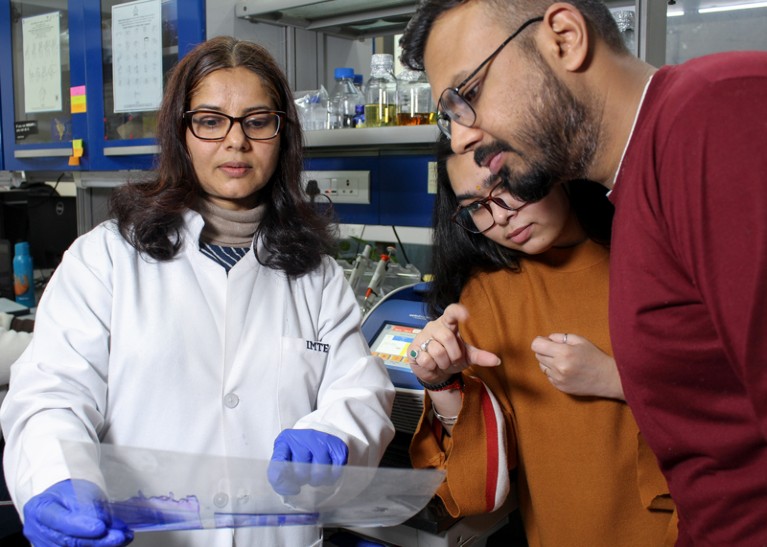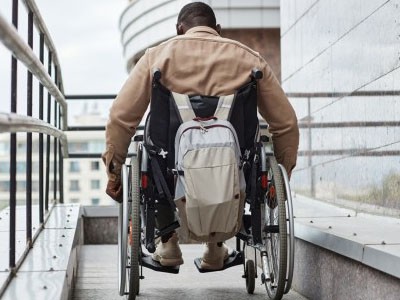
Molecular biologist Alka Rao (left) decodes a laboratory result with the help of sign-language interpreter Sakshi Sharma (centre) and sign-language specialist Digvijay Singh (right).Credit: CSIR IMTECH
In 2016 I had a chance encounter with a social worker who headed the Gurugram branch of the Haryana Welfare Society for Persons with Speech and Hearing Impairments (HWSPSHI), a state-funded organization based in Panchkula, India. I learnt about the gaps in science, technology, engineering and mathematics (STEM) education for deaf children. In India, 63 million people (6.3% of the population) have significant auditory loss, and few of them opt to study STEM subjects. The inherent complexities of these subjects, coupled with the reliance on written and spoken language, create difficulties for both deaf students and their teachers. I started conducting science workshops for deaf students, running interpreter-assisted discussions, and I became a life member of the society.
My interactions with deaf children coincided with a time when India’s government was strengthening measures to further develop Indian Sign Language (ISL). The national agency, the Indian Sign Language Research and Training Center (ISLRTC), was set up in New Delhi in 2015. By 2018, the Gurugram city administration established the first digital sign-language laboratory at the HWSPSHI to convert children’s textbooks for grades one to five (ages five to ten) into ISL videos. In 2021, the Indian government added ISL as an official subject in the national education curriculum, to better serve the more than five million deaf students.
Around the same time, a deaf administrative assistant joined the Council of Scientific and Industrial Research’s Institute of Microbial Technology (CSIR IMTech) in Chandigarh, India. Aware of my association with the HWSPSHI, he approached me regarding his struggles to adjust to the workplace. With some persuasion, IMTech conducted its first sensitivity and inclusion workshop to train employees on how to make appropriate accommodations for deaf staff members. The CSIR later offered the sensitivity workshop and a basic course in ISL at all of its 37 labs around the country.

Collection: Disability and ableism in science careers
The CSIR also set up an outreach programme called Jigyasa, aimed at generating curiosity among schoolchildren and motivating them to opt for STEM subjects in higher education. Beginning in early 2020, scientists from the CSIR’s labs, including IMTech, contributed to a variety of content — comics, infographics, simulations, podcasts and videos — for secondary-school students. Excited by the success of this model, the CSIR decided to translate the content into regional languages. I proposed that these resources should be translated into ISL videos, and I then volunteered to help get it done.
The CSIR granted us funding in December 2021. In 2022, IMTech started the Indian Sign Language Enabled Virtual Laboratory (ISLEVL) project with three deaf sign-language specialists (Digvijay Singh, Neha Kumari and Shubham Bandod), and three hearing staff members (Saurav Roychowdhary and Stuti Kumari, who are sign-language interpreters, and Navjot Singh, a project assistant). Neha Kumari and Digvijay Singh worked together to develop signs and record videos along with Roychowdhary, who served as an interpreter. Stuti Kumari did the voice-overs for the videos, Bandod edited them and Navjot Singh served as a project assistant.
At first, our scope was limited to translation. But we soon realized that ISL had almost no vocabulary for STEM words. If a sign is available in another sign language, for example American or British Sign Language, we can adopt or adapt it. Otherwise, we create new signs.
With active support from research students in my lab, our ISL specialists, including Digvijay Singh and Hoshiyar Singh (who joined the project later), are able to visualize a concept and create signs that depict defining features of a scientific word. This might include its structural or functional features, topology or both. When the sign-language specialists can see equipment, such as a centrifuge, running in my lab, it hastens their visualization and helps them to devise a more fitting sign for the instrument. (The sign for centrifuge in ISL is made by a rotating two-hand shape with extended index fingers, which is used to show centrifugal motion, followed by the right hand in a flat, horizontal hand shape to show the layers of particles separating and settling to the bottom of a test tube.)
We also carefully examine the Latin and Greek root words when we explain any concept to our ISL specialists. For example, the sign for xylem — one of the vascular systems in plants — not only depicts the structure but also the process of transportation in plants. The sign must remain factual, short and as informative as possible without losing its distinct identity. It’s a science, art and imaginative skill.
I’m a lip-reading scientist: here’s how I can discuss science with you
As soon as Digvijay Singh and Hoshiyar Singh have created a sign, it is fine-tuned during discussions with me and ISL specialists, and then posted on our YouTube channel. We have created more than 100 signs and posted more than 500 videos that explain scientific concepts to deaf students. We have just started a STEM news account on Instagram and X (formerly Twitter), which we use to explain the latest technology and trends, such as artificial intelligence, using ISL. The posts have received many likes and we’ve received requests for more content from deaf students. We keep the entire exercise dynamic through feedback from the Deaf community.
To create more content and teaching resources, we conduct workshops for both students and teachers. In March 2022, I ran a deaf-accessible workshop on proteomics. With limited signs, it can be difficult to interpret the information live, so we asked specialists in the field to send us pre-recorded videos that were translated into ISL. At the same time, we held career talks with the help of interpreters who provided live ISL translation. The deaf students and teachers enjoyed the sessions so much that they were reluctant to leave. In November last year, we also conducted a chemistry camp supported by the Royal Society of Chemistry India, in which students ran experiments, such as crystallizing salts, creating different-coloured solutions by adjusting pH and crafting a hydrogel with the help of interpreters and an ISL-translated digital booklet.
In December last year, Hoshiyar Singh presented my lab’s research in ISL at a conference called Bharatiya Vigyan Sammelan in Ahmedabad, India, which promotes science and technology in regional languages.
Although we have great support from the Deaf community, getting the scientific community involved in creating STEM signs and content remains challenging. Without this, the path to STEM learning will remain difficult for deaf children.
This interview has been edited for length and clarity.
